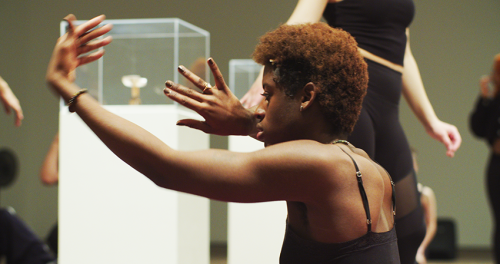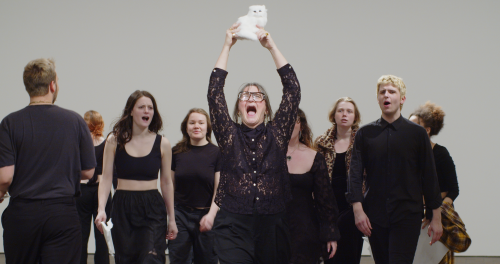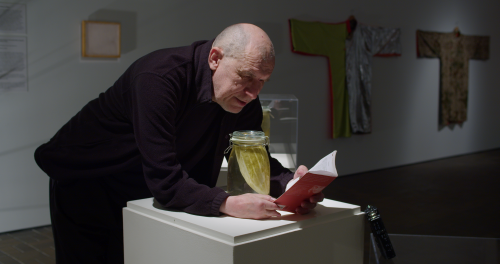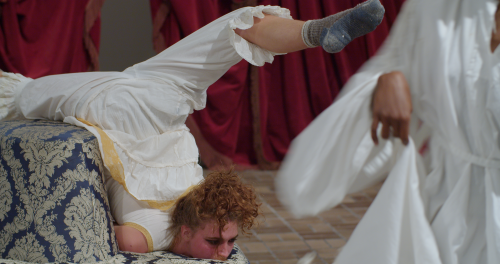Hard Return: 9 Experiments for this Moment
ON VIEW: February 1—May 7, 2023
Hard Return: 9 Experiments for this Moment is a performance art exhibition featuring a series of nine artists creating dynamic week-long experiences, environments, and interactions live in the Neuberger Museum of Art’s galleries.
Over the course of Spring Semester 2023, each of the nine artists will create works that pose fundamental questions about art and life. The projects will experiment with our sense of being alive in this moment, probing the influence of history on our present and proposing different ways of shaping and understanding community—from the intimate experience of one-to-one relationships to attempts to see humanity at planetary scale.
Hard Return promotes modes of artistic activity that the pandemic made impossible for a while and explores the museum as a space of community, reflection, and support.
Past Performances | In the News
A note about the performance schedule
The artworks in Hard Return require performers to exert themselves for long periods of time. If you arrive and find they are not present, it means they are taking a short break and will be back soon. In the meantime, feel free to enter the gallery and look around or explore the other exhibitions on view. Thanks for your patience and understanding.
Past Performances
Brendan Fernandes
February 1-5
Fernandes developed a dance piece in response to African art in the Neuberger collection. Working with vogue expert Jason Rodriguez and a cast of Purchase College students, the artist considered the transmission of cultural forms and knowledges across time and space and from body to body. This work, which changed and grew over the week, will also considered questions of rest and repose. In addition to developing original choreography, the artist offered related movement workshops to museum visitors throughout the week.
See photos and video from the performance
Alix Pearlstein ’88
February 15-19
Exploring a personal archive of objects from previous artworks—props, structures, gestures—with a group of Purchase student actors, Pearlstein’s new commission blurred the lines between then and now, self and other, live and recorded. Improvisational exercises directed by the artist worked to plumb and produce emotional responses to objects or tasks. While the collection is replete with psychological resonance for Pearlstein, the actors encountered it for the first time. As the actions and objects generated new emotional charges, the work grew in excess of what is visible. This work of inventory changed the meaning of Pearlstein’s archive and developed links among the individual collaborators. At the end of each day, a summary performance was committed to video; each video recursively fed back into the work, serving as the next day’s point of departure for further reflection and creation.
See photos and video from the performance
Daniel Bozhkov
February 22-26
With this new commission, Daniel Bozhkov proposes to grow cucumbers on Mars. In the gallery, his project took the form of a five-day-long opera. This is an opera in the expanded sense of the word – a musical play and theatrical performance, but also a work, an act of labor, care, and trouble.
For Cosmic Cucumber Carousel, Bozhkov collaborated with the composer and vocalist Erin Gee to create a five-day opera that embodies a year’s work with gardeners in Bulgaria, soil biogeochemists, and astro-ecologists at Cornell University and The Soil Factory in Ithaca, New York. A cycle of videos featured scientists, fortune tellers, and gardeners making disparate predictions about the fate of the project, as well as Bozhkov and Gee as cantors speculating on the viability of life on this and other planets. Alongside these videos, an assortment of pickled cucumbers—some experimentally grown in simulated Martian soil—and fresco panels framed a group of Purchase College students who performed a one-minute composition by Gee on the hour while wearing garments designed by Bozhkov and Kiwi Phong Nguyen. Another group of students continually embroidered a large curtain that doubled as mise-en-scène and chronicle. Bozhkov’s work asked us to imagine multiple futures—and how our actions in the present make some versions more possible than others.
See photos and video from the performance
Nao Bustamante
March 8-12
A speculum is haunting your OB-GYN. Bloom battled the patriarchal spirits of nineteenth-century gynecology to clear a path to a new achievement in feminist design, a journey into the utopian horizon that performance artist Nao Bustamante calls the “vaginal imaginary.” With this critical investigation into the history of science, Bustamante’s work questioned how power inheres in the tools and practices that contour the nature, meaning, and experience of care—and of our own bodies. Bloom featured original video works, an array of objects related to the artist’s research, and live performance featuring Bustamante, composer and Reiki healing expert Pamela Martinez, and Purchase student actors and musicians.
See photos from the performance
Amber Hawk Swanson
with Davecat and Sidore Kuroneko
March 29 – April 2
Hawk Swanson filmed episodes of The Harmony Show, a multi-faceted talk show she developed with her collaborator, Davecat, and his partner, Sidore Kuroneko, a life-size silicone doll. Created during the early days of the pandemic as a web-based mode of artistic production foregrounding intellectual inquiry and community-building, The Harmony Show explores issues of personhood, desire, race, queerness, disability, and community in two modalities. The first is a seminar in which an invited scholar presents on their work and discusses it with the show’s co-hosts. The second is a cooking show, where a less academically-geared discussion about the same types of issues can unfold as the guest and hosts prepare a meal designed by a recipe developer who specializes in food’s healing properties. As a program designed for an online environment, filming in-gallery with a live audience presented new opportunities for considering public engagement and imagining the community created by the show’s dissemination.
Emily Coates
April 5-9
Coates’ work, Some Things We Know, interwove a multichannel video installation with the creation of an original live performance that meditated on the trope of the cosmic dance—choreography designed to represent, translate, or otherwise embody celestial movements and processes—across time and geographies. Mixing cultural artifacts and performance lineages, personal and cosmic scales, Coates and her collaborators designed a cosmos for the twenty-first century out of the rubble of the twentieth, with the involvement of movers, musicians, and scientists from the Purchase College community.
Autumn Knight
April 12-16
Knight’s sculptural installation and dialogue-based performance work, Complain/Disappoint, featured five performers drawn from the Purchase College community. The performers interpreted and presented action scores that included interaction with sculptural objects created by Knight and the recitation of texts featuring the complaints of people who “are not usually allowed to complain or who we do not expect to hear complaining.” The piece explored affective labor, vulnerability, and the extraordinary expectations placed on certain types of workers we ask to shoulder other’s burdens while ignoring that they have their own.
Patty Chang
with Anne Bourne, Astrida Neimanis, and Aleksija Neimanis
April 26-30
In collaboration with veterinary pathologist Aleksija Neimanis, feminist cultural theorist Astrida Neimanis, and composer Anne Bourne, performance artist Patty Chang presents a participatory, immersive environment that is grounded in a larger research project, Learning Endings. This multimedia performance contemplates caring for life and caring for death in the context of climate change through marine mammal necropsy.
Jesus Benavente
May 3-7
Benavente presented a series of installations and interventions in the gallery and across the Purchase College campus on a rotating, irregular schedule. The artist worked with students to produce gatherings that had the aesthetics of protest to investigate what turns a group into a politicized bloc. Large inflatable sculptures filled the gallery, altering one’s perception of space and transforming the solemn museum into an overstuffed funhouse. Sometimes, a mariachi band appeared. The collection of spatial invitations and interventions explored the ways our surroundings shape our sense of self and the permissible—what it is OK to do, and what it is not OK to do—and offered moments and glimpses of how people can push back on these limitations and expand our sense of the possible.
On Saturday, May 6, during I’m Not Dancing, I’m Struggling to Survive, museumgoers were invited to a dance party with music and lights, all of which alternate between a celebratory club atmosphere and a surveilled crime scene.
Hard Return In The News
Print: Hyperallergic Spring Art Guide (page 7)
Feb 16: News 12: Expand your mind and indulge in inspiration at the Neuberger Museum of Art in Purchase
Feb 3: News 12 “On A Positive Note: Performance Artist Hosts Vogue Ball at Purchase College”
Feb 3: Arts Westchester “Installations and Interventions: Performance Art at the Neuberger”
Feb 2: ArtDaily “Groundbreaking performance art exhibition opens at the Neuberger Museum of Art”
Jan 25: Hyperallergic “Groundbreaking performance art exhibition opens at the Neuberger Museum of Art”
Hard Return: 9 Experiments for this Moment is organized by the Neuberger Museum of Art, Purchase College, SUNY, and co-curated by Purchase College faculty members Kate Gilmore, a renowned performance artist, and Jonah Westerman, an art historian who specializes in performance art.
Generous financial support for this exhibition has been provided by the National Endowment for the Arts, the Friends of the Neuberger Museum of Art, and the Purchase College Foundation. Additional support of the student participation in Hard Return has been provided by Ivan Bart & Grant Greenberg and Ava & Paul Zukowsky.
A Note on Performance Art
by Professor Jonah Westerman
Co-Curator, Hard Return
“Performance” itself can be an intimidating and confusing word when it comes to describing artworks. Since the 1970s, “performance” has become a way to describe modes of artistic activity that do not fit neatly into other categories–like painting, sculpture, photography, video, dance, theater, etc.–or flout their conventions. At the same time, works described as performance often include or borrow from these traditional mediums. Performance itself, however, is not a medium—not something that a work of art can be—but is rather a set of questions about how art relates to people and the wider social world. Describing artwork as performance emphasizes the processes through which it is created and received. It destabilizes the line between two usually sequential procedures to acknowledge the many ways a work is made at the place and time where it meets its audiences.



